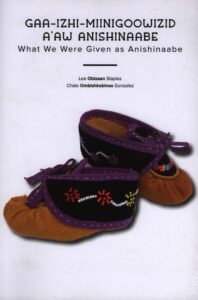Book review: Gaa-izhi-miinigoowizid a’aw Anishinaabe: What We Were Given as Anishinaabe
 Reviewed by Karl Hele
Reviewed by Karl Hele
Lee Obizaan Staples and Chato Ombishkebines’ monograph is an excellent source for Anishinaabe seeking to learn about and potentially follow traditional ceremonies. Gaa-izhi-miinigoowizid a’aw Anishinaabe: What We Were Given as Anishinaabe is the teachings offered by Obizaan as related and recorded by his ceremonial apprentice Ombishkebines. The text, both English and Anishinaabemowin, were created under the guidance of Obizaan. These are the words of an Elder and man deeply enmeshed in Anishinaabe culture and ways of knowing. The teachings Obizaan shares begins with before birth to fasting ceremonies as well as chapters on the importance of disciplining our children and the importance of teaching our children about Anishinaabe ways. Throughout the text, Obizaan argues that without learning about our spirituality, customs, and language, children will wander aimlessly in life and never know the true importance of being Anishinaabe. Overall, Gaa-izhi-miinigoowizid a’aw Anishinaabe: What We Were Given as Anishinaabe is an attempt to bring and share important knowledge with people in an effort to revitalize culture and ceremony – to recentre the Anishinaabe and bring balance to help all of us enjoy the good life.
By incorporating both languages into the work, as well as providing a glossary at the end of the book, Obizaan and Ombishkebines are undertaking a couple of tasks. First, they are sharing knowledge with those Anishinaabe who did not grow up in the language. The lessons in English, while lacking the depth of knowledge contained in Anishinaabemowin, do offer knowledge and advice about raising children in the Anishinaabe way. Second, it acts as a primer to encourage people to seek a deeper meaning by learning the language. The authors, while lamenting language loss, offer their work as a way to reclaim what has been lost or damaged by colonialism. Finally, the book with its Anishinaabemowin and English translations can be used as a tool in classes to teach both the language and the culture together. I love this aspect of the work.
The text is designed to offer teachings to both youth and adults. The information within its pages are not detailed descriptions of ceremony; instead, the lessons offer glimpses while imparting the importance of our culture and way life as well as continued relevance in the modern world. Obizaan stresses that we must begin by educating our children, and that it is never too late to teach them. Additionally, he notes that it is also not too late for adults to learn about and follow the Anishinaabe path. For him, we must “foster a relationship with the Manidoog” to find “the path that was intended for each of us individually.”(3). Thus, Gaa-izhi-miinigoowizid a’aw Anishinaabe is a work of love — love for the culture, teachings, and language as well as of us, the Anishinaabe. I believe that Obizaan wants us to connect with our culture and language so we have a future as a people.
I found the words of Obizann both illuminating and deeply moving. The book is admirably suited for readers of all ages. It serves as a primer on both ceremony for children and lessons for adults as well as a vehicle for language acquisition, especially for Anishinaabemowin courses. Hence, GGaa-izhi-miinigoowizid a’aw Anishinaabe is a great addition to one’s collection of works on Anishinaabe language and culture, and like other similar materials it must be read and used to be truly appreciated and have a positive impact on knowing our ways.
Lee Obizaan Staples and Chato Ombishkebines Gonzalez, Gaa-izhi-miinigoowizid a’aw Anishinaabe: What We Were Given as Anishinaabe. St. Paul, MN: Minnesota Historical Society Press, 2023.
ISBN: 1681342677


